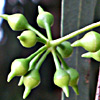River Red gum (Eucalyptus camaldulensis) is an evergreen tree that originates from Australia, where it creates a landscape of expansive forests. It grows rapidly, and can reach a height of 35 meters or more. Its trunk thickens as years go by, and if it is not felled, it reaches impressive dimensions. The bark of the tree is light brown. The bark peels in sections that detach from the trunk, curl and fall. A light colored and smooth bark is exposed underneath, which will also peel in the future as the bark and branches thicken. The leaves are lanceolate, leathery, somewhat asymmetrical and light green. When the leaves are rubbed, they emit a characteristic odor of the essential oils they contain. The young branches and leaves hang downward. The leaves turn their side to the sun, thus reducing water loss. The leatheriness of the leaves is also not conducive to rapid water loss.
Eucalyptus camaldulensis blooms almost all year, satisfying bees and beekeepers. The flowers are bisexual, arranged in a simple corymb-like inflorescence carried on a peduncle. The flower buds are covered by a green capsule. At its center a beak-like protrusion which is the origin for the Hebrew species’ name. The bud cover is constructed of the petals. During blossom the capsule is shed and numerous white-yellowish stamens spread out. The flowers emit a strong scent which attracts bees. The ovary is inferior and connected to the receptacle. The fruit is a capsule that opens in 4-5 loculi and disperses numerous seeds. There is great variability in the times of bloom of different trees of this species, and blooming trees can be found in the forest almost all the time.
Eucalyptus camaldulensis is a species that originates from Australia, and is a stranger in Israel. As a stranger it has important advantages, among others that it is easy to reproduce and grow it, and on the other hand it does not reproduce in an uncontrolled manner in the hosting country. It is second only to Pinus halepensis in the competition for the title “the most commonly planted tree in Israel”.
The tree was brought to Israel in the late 19th century, and was used especially for planting in flooded areas, because of its reputation as “dryer of swamps”. Indeed, it is resistant to conditions of prolonged flooding, and on the other hand in the summer when the water level decreases the root system recovers rapidly and the tree absorbs water also from the depth of the soil. However, it is frugal in water consumption. Thus, it is not very effective for drying swamps.
After felling the tree renews from the stump, and proper thinning of the renewing branches leads to a new growth cycle of valuable trunks. Its ability to grow well under extreme conditions, from flooded areas to the edge of the desert, enabled planting small shade groves of eucalyptus trees in water catchments on roadsides in the Negev Desert.
Because of its rapid growth, the essential oil in its leaves and the nectar in its flowers, it is considered as having some economic value. The essential oil is added to cosmetics, some sweets and medicines. The flowers attract bees, and “eucalyptus honey” is known for its high quality. Beekeepers therefore place beehives near eucalyptus groves. Eucalyptus wood is used mainly for simple uses such as hedges and fences. It is claimed that it is also used in the wood and furniture industry, but it is not considered high quality wood, and is not commonly used for this purpose because it requires special methods while drying. Its overall economic contribution is negligible, and it is used mainly for shade and relaxation as well as for honey.
In the early years after the establishment of the State of Israel, boulevards of eucalyptus trees were planted along roads. It is said that this was carried out under the personal instruction of the Prime Minister and Minister of Defense, David Ben-Gurion, in order to make it difficult for the enemy to discover movement on roads and observations, and the boulevards were jokingly called “Ben-Gurion Boulevards”. It was later found that every road would in future be widened, and that the eucalyptus trees make this difficult. They also do not block the scenery and there were those who suggested that the boulevards should be planted along the roads discontinuously, with intermittent “scenery windows”. Today eucalyptus trees are planted over an area of 9,000 ha, two-thirds of which are in the south of Israel.
The genus Eucalyptus contains 700 species of trees and shrubs, most in Australia and Malaysia. These include individuals of the species Eucalyptus regnans which compete for the title of “the tallest tree in the world” and reach a height of 100 meters. Sixty species are grown in Israel, where most of the individuals belong to the species Eucalyptus camaldulensis.
Written by Erga Aloni and Mike Livne







